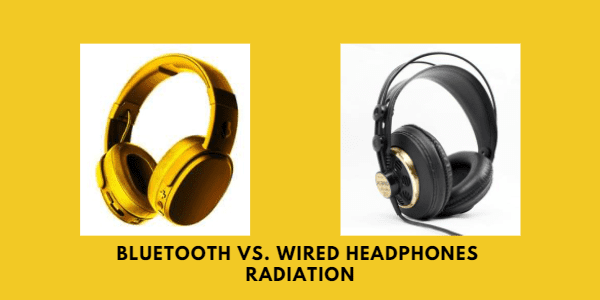To avoid tangled wires, wireless devices are the most recent technological advancements. Wireless Bluetooth headphones are just as good as wired counterparts. However, they operate at 2.4GHz, the same frequency as most modern wireless devices. As a result, the danger of EMF emissions persists. Even the majority of commonplace wired headphones aren’t all that secure.
In the Bluetooth vs. wired headphones radiation debate, it’s clear that wired headphones come out on top. When compared to Bluetooth headphones, they produce significantly less electromagnetic field radiation (EMF). Ferrite beads and air tube headphones help reduce noise pollution even further. Bluetooth headphones don’t have any of these features.
This article will compare the radiation emitted by Bluetooth and wired headphones to explain why we’ve already declared wired headphones the winners. In addition, we’ll go over some strategies for reducing your body’s exposure to EMF while wearing earbuds. In addition, we’ll cover air tube headphones briefly. We are ready to go now.
Bluetooth vs. Wired Headphones Radiation
Bluetooth headphones emit EMF radiation
As with wired headphones, Bluetooth headphones provide a hassle-free listening experience. We’ve all had to deal with tangled earphone wires at some point or another. Nearly zero latency can be achieved with Bluetooth headphones, thanks to the advancements in technology.

However, there is a significant concern. EMF radiation is pervasive in our daily lives. Any electrical device, including Bluetooth headphones, emits electromagnetic radiation (EMF). Everything electrical, wired or wireless, emits electromagnetic radiation (EMF), whether powered by a battery or directly from the power source. We’re constantly exposed to radiation, even though the level is low, and that’s a cause for concern.
Bluetooth headphones do emit a significant amount of electromagnetic radiation (EMF). Like most other wireless audio accessories, Bluetooth headphones operate via radio waves in the electromagnetic spectrum. Wi-Fi routers, cell phones, and other intelligent devices are examples of this.
Headphones that use Bluetooth technology emit both EMF and RF radiation. RF radiation is electromagnetic radiation at a radio frequency. Circuits with an electric current generate electromagnetic radiation (EMF). We can quickly tell that Bluetooth headphones emit more radiation than other headphones.
EMF radiation is constantly emitted by Bluetooth headphones when they are powered on and connected to a device or not. A common misconception is that Bluetooth headphones are more secure than cell phones or other wireless devices because they are smaller. This is false. The frequency of the radiation is the only thing that matters.
Depression can result from long-term exposure to Bluetooth headphone radiation. According to some studies, cancer may be caused partly by the radiation emitted by Bluetooth headphones. Depressive symptoms can arise due to being exposed to Bluetooth headphones regularly for an extended time. There is a direct correlation between music volume and how long you’ve been listening.
Wired headphones emit EMF radiation
Headphones with a wired connection are the first in a long line. Although they are the oldest type of headphones, they are still used today. You can use analog or digital wired headphones. The 3.5mm jack connects analog headphones, while the USB port connects digital headphones.
Wired headphones emit EMF radiation because they are powered by electricity. It would help if you grasped the subtle differences at play. Due to the electrical circuitry, wired headphones only emit EMF radiation. Due to wireless components in this device, they do not emit any radiofrequency radiation. We use headphones closer to our bodies than any other wireless device, which is the most significant risk for wireless devices. It’s all about proximity, not radiation level.

Wired headphones expose the entire ear canal and brain to electromagnetic radiation (EMF). Both ear cups are wired together in a circuit to flow between them. We are subjected to EMF radiation on our entire head from every angle.
EMF can cause a wide range of health issues when using wired headsets. Insomnia, sleep disturbance, headaches, and other symptoms can be experienced by those who suffer from the condition. Both wired and wireless Bluetooth headphones generate EMF radiation, but the levels are pretty different. The dangers remain, however.
Also read: Can You Sleep with AirPods In?
Concerns About EMF Radiation From Headphones
To recap this Bluetooth vs. Wired Headphones Radiation tiff, both wired and Bluetooth headsets emit electromagnetic radiation (EMF). Even though the amount of radiation emitted by headphones is minimal, you use them for more extended periods and closer to your body than any other gadget. As a result, we should be concerned about many EMF radiation risks:
Headache
The most common side effect of listening to music through headphones for an extended time is a headache. We prefer to listen to music through headphones situated as close to our heads as possible. We’re exposed to EMF radiation from both ears when talking on a phone, but that’s not the case when wearing headphones. This raises the danger level.
According to this study, headaches were more severe when people used cell phones and Wi-Fi. Corded landlines, on the other hand, had little impact. This establishes a link between headaches and exposure to electromagnetic fields (EMFs). Other studies have shown a link between EMF exposure and headaches.
Sleep disturbance
We’re more likely to develop long-term health issues if we don’t get enough sleep. Our productivity improves when we get enough sleep. Our next day can be affected by any disruption in our sleep. A lack of sleep can exacerbate chronic conditions such as hypertension, diabetes, and more.
EMF radiation and sleep have been linked in a study published in 2012. Sleep can be disrupted by intermittent exposure to EMFs. It also shows that EMF exposure at night is more harmful than during the day. It’s alarming how often people listen to music or play video games late at night while wearing headphones.

Reduced work hours in industries where workers are exposed to EMF have been shown in previous research to improve sleep quality.
Carcinoma
Cancer is directly linked to radiation exposure. The DNA structure of cells is damaged by ionizing radiation, which facilitates cancer development. Non-ionizing EMF radiation, on the other hand, poses a low risk of cancer compared to high radiation levels. However, according to this study, you cannot ignore the risks entirely.
Electromagnetic radiation can cause tumors to grow, leading to cancer (EMF). According to a new study, electrical workers were found to have a higher risk of developing leukemia. Despite the results, we should remain cautious.
Mitigate the Risks of EMF Radiation by Headphones
As unpleasant as EMF exposure can be, it’s perfectly acceptable to be concerned about the dangers it poses. The following are some of the methods you can use to reduce EMF radiation by using headphones:
Use wired headphones
Wired headphones are far more secure than Bluetooth headphones, as we’ve already discussed. Unlike Bluetooth headphones, wired headphones only emit low levels of electromagnetic radiation (EMF). In our daily lives, headphones are essential. Because of this, wired headphones are the best option. Alternatively, an air tube headset can be used, which we’ll discuss later.
Use ferrite beads
Every one of you has come across ferrite beads at some point in your life. Cords with plugs have a cylindrical-shaped bead at the end, just before the plug, on all electrical devices. The ferrite bead is that bead. The bead has a coil of wire running through it, sandwiched between layers of ferrite.
Electrical equipment is protected from surges or spikes of electricity by the ferrite bead. It also significantly reduces EMF. Ferrite beads are not included in any wired headphones, but you can buy them and install them yourself if you prefer.
Use speaker
Consider using speakers if you’re having a conversation or listening to music with a friend. Even though headphones are more convenient, it is not recommended for extended periods because of the known dangers of long-term exposure to electromagnetic fields (EMFs).
Don’t use headphones for longer periods
To reduce the risk, this is a critical step to take. Use headphones for only a few hours at a time. Even if you use Bluetooth headphones, taking a break reduces EMF radiation exposure. Consequently, the risk of EMF-related complications is reduced.
Keep the audio source away
Moving the audio source further away from your ears significantly reduces the signal’s strength. If you’re using Bluetooth headphones, you can take advantage of this feature. These days, you can use Bluetooth headphones wirelessly up to a distance of 30 feet without any issues. You don’t have to compromise sound quality to reduce EMF risks.
EMFs in Daily Life
Learn about some of the most common electromagnetic fields (EMFs) you may encounter in your daily life by reading on!
Power lines
High-voltage transmission lines produce the most robust electric fields we encounter in our daily lives. Before it reaches your home or business, transformers reduce this high voltage. In addition, the walls of your house provide some protection. You can find the strongest magnetic field right under the power lines.
In both electric and magnetic fields, distance has a significant effect. Field strength diminishes the further you are from high-voltage power lines. The background magnetic field in homes near power lines may be relatively low.
Televisions and computer screens
Like television sets and computer screens, they generate magnetic and electric fields at different frequencies. There are no significant electric and magnetic fields generated by LCD screens.
In light of this, LCD, LED, and plasma screens used in modern televisions emit only small amounts of radiation. It’s sufficient, however, to ensure that children do not get too close. It’s not considered dangerous to watch from a few feet away on a couch.
Wireless devices
Radiofrequency (RF) devices sold in the United States must meet FCC guidelines for safe exposure to human radiation. Devices with a Specific Absorption Rate (SAR) of less than 6 GHz are subject to a limit set by the FCC for use near or on the body. RF energy absorption is measured in this area. FCC regulations state that each kilogram of weight is limited to 1.6 milliwatts of power.
The FCC certifies that all wireless devices sold in the United States do not exceed FCC exposure limits. Here, the FCC adds a safety margin for error. The FCC has the power to revoke its approval of a product if it discovers that it does not meet its stated specifications.
Go to the FCC ID Search database and enter your phone’s FCC ID number to find the SAR value. You can find the device’s serial number by looking at its case. To find the serial number, you may need to remove the battery.
Microwaves
This technology is used to detect speeding cars, send television communications, raise bread, and even cook potato chips! Toaster ovens and microwaves are the most common devices that harness microwave radiation power.
You can safely operate a microwave oven if you follow the manufacturer’s instructions. Microwave radiation and superheating have resulted in burns and other injuries, mainly due to misuse. Despite their high power, microwave ovens feature radiation shields that virtually eliminate leakage outside the oven.
The FDA Trusted Source limits microwave leakage from an oven to 5 milliwatts Trusted source per square centimeter, measured about 2 inches away. According to the FDA, this limit is well below the level that has been shown to cause harm.
If the door of a microwave oven is left open, it must have safety features to prevent the generation of microwaves, which can be dangerous. Ovens are tested in the FDA laboratory to ensure compliance with the agency’s standards. There must be a label on every oven sold in the US stating that it meets the safety standard.
Conclusion
It’s important to know that Bluetooth headsets can produce higher radiation levels. Because of this, you should take breaks whenever you use these for an extended time. Preventing radiation-related health problems will be easier with this new technology.
For the most part, it’s a matter of personal preference as to whether you want wired or wireless headphones. You can try both and see what provides the most comfort, but remember to take breaks regardless. You’ll be protected and still get the best deal possible this way!
In this article regarding Bluetooth vs. wired headphones radiation, we have covered all points about which one to choose. We hope you can make a suitable decision based on the points discussed above.

